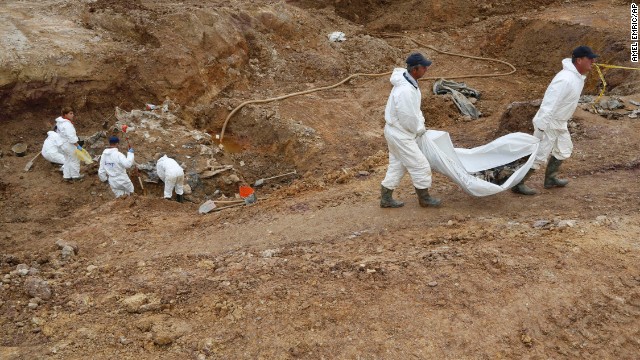
Mass grave found in Bosnia
Investigators in Bosnia have uncovered a mass grave thought to contain several hundred bodies of victims of the conflict that followed the breakup of the former Yugoslavia two decades ago.
The remains are believed to be those of victims of Bosniak and Croat ethnicity from Prijedor and its surroundings, killed in the summer of 1992, according to the Prosecutor’s Office of Bosnia and Herzegovina.
The site, at Tomasica in Prijedor municipality, is one of the biggest mass graves found in Bosnia and Herzegovina since the conflict, said Boris Grubesic, a spokesman for the prosecutor’s office.
As of Thursday, 231 complete bodies had been exhumed, as well as the body parts of another 112 people.
But, he added, the number found goes up by the day or even the hour.
More than 30 personal items have also been found, he said.
Excavation of the mass grave, which goes to a depth of 10 meters (33 feet), began in early September and is expected to continue into next week.
The remains are being taken to an identification center in Sanski Most, where they will remain until the forensic analysis and identification process is completed, the prosecutor’s office said.
Representatives of the International Commission on Missing Persons, the interior ministry for Bosnia and Herzegovina and the prosecutor’s office are present for the dig, as well as an expert forensic pathologist.
Missing relatives
Identification of the remains may help bring closure for the many families whose relatives vanished in the course of the conflict, which ended in 1995.
About 9,000 people are still missing, about 30% of all those reported after the conflict. Another 22,000 have been accounted for, according to the International Commission on Missing Persons.
Ambassador Peter Sorensen, head of the delegation of the European Union to Bosnia and Herzegovina, was part of a delegation that visited the Tomasica site just over a month ago, when he spoke of the thousands still missing.
“Their families have the right to know what happened to their missing relatives,” he said. “Governments, military authorities and former armed groups have an obligation to provide all the relevant information they hold, and assist in efforts to put families back together.”
He and others also visited another grave site under excavation, this one at a garbage disposal site in Sarajevo.
Witness statements suggest that as many as 100 bodies may be found there, but two decades worth of garbage must first be removed, according to a statement from the International Commission on Missing Persons.
Kathryne Bomberger, director general of the commission, praised the work of the investigators, saying that the excavation works at the two sites were “some of the most complex undertaken in the region.”
“The process of investigating these disappearances is a painstaking one which requires careful excavation of clandestine gravesites and precise documentation of evidence that is recovered,” she said.
War crimes trials
The International Criminal Tribunal for the former Yugoslavia, a U.N.-backed court, continues to prosecute war crimes committed during the conflicts in the Balkans in the 1990s.
Four cases remain at trial, including that of former Bosnian Serb leader Radovan Karadzic, accused of genocide, crimes against humanity and war crimes.
The other three on trial are former Bosnian Serb army leader Ratko Mladic, who’s indicted for genocide and other war crimes; Croatian Serb rebel leader Goran Hadzic, accused of crimes against humanity and war crimes; and Vojislav Seselj, a Serb nationalist politician who faces charges of crimes against humanity and war crimes.
The tribunal said “the most significant number” of its cases dealt with alleged crimes by Serbians or Bosnian Serbs.
But there have been convictions for crimes against Serbs by others, including Croats, Bosnian Muslims and Kosovo Albanians.
Serbia’s president declines to define killing of 8,000 in Srebrenica as ‘genocide’


Leave a reply